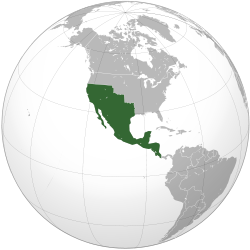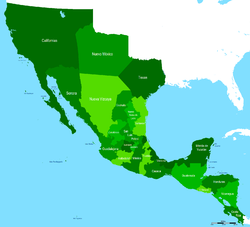- First Mexican Empire
-
"Mexican America" redirects here. For the professional wrestling stable, see Mexican America (professional wrestling).
Mexican Empire
Imperio Mexicano← 
←
1821–1823  →
→
 →
→

Flag Imperial Coat of arms Motto
Religión, Independencia, Unión.
Religion, Independence, Union.Capital Mexico City Language(s) Spanish Religion Roman Catholicism Government Constitutional Monarchy Emperor - 1822–1823 Agustín I Prime Minister - 1822–1823 José Manuel de Herrera Legislature Congress - Upper house Senate - Lower house Chamber of Deputies History - Independence of Mexico September 27, 1821 - Agustín I of Mexico July 21, 1821 - Monarchy overthrown March 19, 1823 Area 4,925,283 km2 (1,901,662 sq mi) Currency Mexican real Today part of  Belize
Belize
 Costa Rica
Costa Rica
 El Salvador
El Salvador
 Guatemala
Guatemala
 Honduras
Honduras
 Mexico
Mexico
 Nicaragua
Nicaragua
 United States
United StatesThe Mexican Empire was the official name of independent Mexico under a monarchical regime from 1821 to 1823. The territory of the Mexican Empire included the continental intendencies and provinces of New Spain proper (including those of the former Captaincy General of Guatemala). Soon afterward Mexico declared itself a republic, but then reverted to a monarchy during the Second Mexican Empire.
Contents
History
After the declaration of independence on September 15, 1821, it was the intention of the Mexican parliament to establish a commonwealth whereby the King of Spain, Ferdinand VII, would also be Emperor of Mexico, but in which both countries were to be governed by separate laws and with their own legislative offices. Should the king refuse the position, the law provided for a member of the House of Bourbon to accede to the Mexican throne. Ferdinand VII, however, did not recognize the independence and said that Spain would not allow any other European prince to take the throne of Mexico. By request of Parliament, the president of the regency Agustín de Iturbide was proclaimed emperor of Mexico.
The First Mexican Empire was short-lived, lasting only eight months, from July 21, 1822 to March 19, 1823, and was ruled by only one emperor, Agustín de Iturbide, also known as Agustín I of Mexico.
Background
After Napoleon I invaded Spain in 1807 and put his brother, Joseph, on the Spanish throne, Mexican Conservatives and rich land-owners who supported Spain's Bourbon royal family objected to the comparatively liberal Napoleonic policies. Thus an unlikely alliance was formed in Mexico: liberales, or Liberals, who favored a democratic Mexico, and conservadores, or Conservatives, who favored a Mexico ruled by a Bourbon monarch who would restore the status quo ante bellum. These two elements agreed only that Mexico must achieve independence and determine her own destiny.
Taking advantage of the fact that Spain was severely handicapped under the occupation of Napoleon's army, Miguel Hidalgo y Costilla, a Catholic criollo priest with progressive ideas, declared Mexico's independence from Spain in the small town of Dolores on September 16, 1810. This act started the long war, the first official document of independence was the Solemn Act of the Declaration of Independence of Northern America signed in 1813 by the Congress of Anáhuac. Eventually led to the official recognition of independence from Spain in 1821 and the creation of the First Mexican Empire. As with many early leaders in the movement for Mexican independence, Hidalgo was captured by opposing forces and executed.
Prominent figures in Mexico's war for independence were Father José María Morelos, Vicente Guerrero, and General Agustín de Iturbide. The war for independence lasted eleven years until the troops of the liberating army entered Mexico City in 1821. Thus, although independence from Spain was first proclaimed in 1810, it was not achieved until 1821, by the Treaty of Córdoba, which was signed on August 24 in Córdoba, Veracruz, by the Spanish viceroy Juan O'Donojú and Agustín de Iturbide, ratifying the Plan of Iguala.
- It was the intention of the Mexican Parliament, when it ratified the Plan of Iguala, to establish a commonwealth, whereby the King of Spain, Ferdinand VII, would also be Emperor of Mexico, but in which both countries were to be governed by separate laws and with their own legislative offices. Should the king refuse the position, the law provided for another member of the House of Bourbon to accede to the Mexican throne. Ferdinand VII, however, did not recognize the independence and said that Spain would not allow any other European prince to take the throne of Mexico.
- Later that year, General Agustín de Iturbide, a Mexican criollo who originally fought for the pro-Spanish royalists but switched his allegiance to the insurgents in the final phases of the war, was elected head of the provisional junta government and of the regency that held the imperial power that Spain once had. On the night of the May 18, 1822, a mass demonstration led by the Regiment of Celaya, which Iturbide had commanded during the war, marched through the streets and demanded that their commander-in-chief accept the throne.
Establishment
History of Mexico 
This article is part of a seriesPre-Columbian Mexico Spanish conquest Colonial period War of Independence First Empire First Republic War with Texas Pastry War Mexican–American War Second Federal Republic The Reform Reform War French intervention Second Empire Restored Republic The Porfiriato Revolution La decena trágica Plan of Guadalupe Tampico Affair Occupation of Veracruz Cristero War The Maximato Petroleum nationalization Mexican miracle Students of 1968 La Década Perdida 1982 economic crisis Zapatista Insurgency 1994 economic crisis Downfall of the PRI
Mexico Portal
On May 19, 1822, the Sovereign Congress named Iturbide emperor. On May 21, 1822, it issued a decree confirming this appointment, which was officially a temporary measure until a European monarch could be found to rule Mexico. Iturbide's official title was "By Divine Providence and the National Congress, First Constitutional Emperor of Mexico" (Spanish: Por la Divina Providencia y por el Congreso de la Nación, Primer Emperador Constitucional de México). His coronation took place on July 21, 1822, in Mexico City. As factions in the Congress began to sharply criticise Iturbide and his policies, the emperor decided on October 31 to dissolve it. This enraged the commander of the garrison at Veracruz, Antonio López de Santa Anna, who himself would be President for several terms, during the Secession of Texas and the disastrous Mexican-American War. Santa Anna and his troops revolted against Iturbide and declared a republic on December 1.
Defeat and abolishment
In December 1822, Generals Antonio López de Santa Anna and Guadalupe Victoria wrote and signed the Plan of Casa Mata. This was an agreement between these two generals, amongst other Mexican generals, governors, and high-ranking governmental officials, to abolish the monarchy and replace it with a republic. Several insurrections arose in the Mexican provinces beginning in December, but they were all put down by the Imperial Army, except for Santa Anna's forces in Veracruz. This was because Santa Anna had previously made a secret agreement with the General Echávarri, the commander of the Imperial forces. By this agreement, the Plan of Casa Mata was to be proclaimed throughout Mexico on February 1, 1823 and Echávarri was to switch sides. This plan did not recognize the First Mexican Empire and called for the convening of a new Constituent Congress. The insurrectionists sent their proposal to the provincial delegations and requested their adherence to the plan. In the course of just six weeks, the Plan of Casa Mata travelled to such remote places as Texas, and almost all the provinces supported the plan.
When a provincial delegation accepted the Plan de Casa Mata, it withdrew its allegiance to the Imperial government and assumed sovereignty within its province. As a result, Agustín de Iturbide was isolated with little support outside his capital, Mexico City, and a few factions of the Imperial Army. Consequently, he re-installed the Constituent Congress, which he had previously abolished, abdicated the throne, and fled the country on March 19, 1823.
Territory
The first Mexican empire was divided by the following intendences.
- Las Californias
- México
- Nuevo México
- Texas
- Nueva Vizcaya
- Coahuila
- Nuevo Reino de León
- Nuevo Santander
- Sonora
- Zacatecas
- San Luis Potosí
- Guanajuato
See also
- Mexican Empire, an overview of periods of Monarchy in Mexico
- Second Mexican Empire
- Federal Republic of Central America
External links
Monarchies in the Americas Current Indigenous monarchiesSettled monarchiesFormer Indigenous monarchiesAraucania and Patagonia · Aztec · Brazil · Haiti (1804-1806) · Haiti (1811-1820) · Haiti (1849-1859) · Inca · Maya · Mexico (1822-1823) · Mexico (1864-1867) · Miskito · TaínoColonial monarchiesRelated List of monarchs in the Americas · List of the last monarchs in the AmericasCategories:- Former countries in North America
- Former empires
- States and territories established in 1821
- States and territories disestablished in 1823
- Independent Mexico
- History of Mexico
- Former monarchies of North America
- Mexican monarchy
- Mexican Empire
- Nobility of the Americas
- States and territories established in 1822
- 1823 disestablishments
- 19th century in Mexico
Wikimedia Foundation. 2010.



